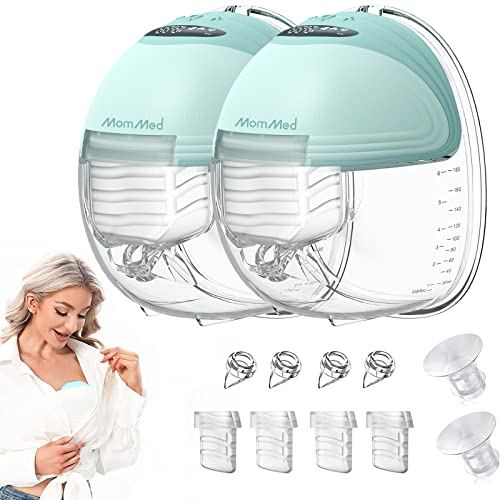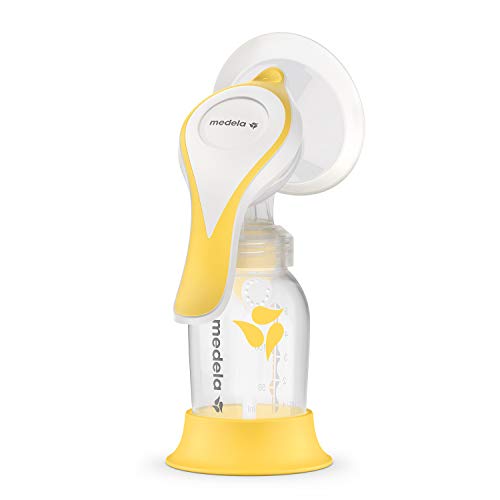

For mom’s on-the-go, a wearable breast pump can be a desirable option to make pumping more convenient. The MOMMED Breast Pumps are a wearable option that sits comfortably under your clothes or in your nursing bra so you can pump hands-free. These pumps feature 12 levels and three modes to customise milk expression and maximise milk production. The pumps close securely to prevent leaks, and they are easy to take apart for cleaning. They come with a measuring gauge on the side so you can closely monitor your output.
These lightweight breast pumps allow you to pump while driving, working, or cooking, so you can get back to doing the things you want to do without worrying about a pump break. They feature a quiet operation and sleek design that is easy to use and discrete. The LCD screen makes it easy to switch functions and modes without interrupting the flow. The cordless operation means you can move around while you pump. These breast pumps get the top spot on this list for their discrete design and convenient features.
The Jheppbay Breast Pumps are ideal for moms who want to pump in public discretely and conveniently. This option features a variety of settings and modes to improve milk output and make pumping more comfortable. The included remote allows you to operate the pumps hands-free without removing them. You can easily turn the pumps on and off, change the settings, and adjust the stimulation features without removing the pumps in public. This feature makes these pumps ideal for pumping in your office or a restaurant.
The silicone cups are leak-resistant and are easy to clean after use. They allow you to measure your milk production and assess your pump needs easily. The wearable design fits smoothly under your bra to allow you to pump while on the go. The flange fits a variety of breast and nipple sizes to provide an even suction without leaks. Busy moms will also love the long battery life. You can use this breast pump for 6-8 hours before recharging it, which will last through your workday or a long road trip.
Most moms need a quiet option that discretely fits under their clothes to pump in public. The Momcozy Breast Pump is ideal for pumping in public thanks to its quiet operation and sleek design. These pumps are easy to place under your shirt for a mid-day pump session. They are comfortable to wear and feature a powerful suction to ensure your pumping sessions are worthwhile. The double-sealed flange prevents spills and ensures good suction. The design of the flange also promotes milk production when combined with the appropriate settings.
This breast pump has nine levels and three modes to express more milk throughout your pump session. With your hands-free while you pump, you can get ready for the day, send emails, or play with your baby without taking a break to pump. The screen allows you to see the time left and the mode setting, and the convenient buttons allow you to adjust the settings easily. This breast pump features a long battery life and quick recharging to prevent a dead battery from getting in the way of your life.

A manual pump may be the solution if you struggle with milk production or expression when using electric pumps. The Medela Breast Pump is a manual pump with a smooth fit that allows you to express your milk by hand. You can control the speed and duration of your pump sessions and mimic your baby’s natural sucking rhythm. This pump is compact and discrete to fit in your diaper bag or purse easily.
This breast pump is easy to disassemble and clean with your bottlebrush or washcloth. It comes with everything you need, including a bottle and flange. The ergonomic design keeps you comfortable as you pump, and the silicone flange provides a tight seal that prevents leaks. Without the noisy motor, you can pump quietly at night while your partner and baby sleep.
The Lasinoh Breast Pumps are ideal if you’re looking for a more classic design to maximise production and improve your output. These pumps can be battery-powered for on-the-go use or plugged into the motor directly. The fit is comfortable on your breast and prevents leaks and spills with a tight suction.
The included bottles capture the milk and store your milk in the fridge for several hours, making this pump perfect for working moms who need to store their milk until they get home. The pumps will phase through the settings to simulate your baby’s natural nursing pattern. This feature makes this option ideal for moms who pump and nurse simultaneously. The LCD screen is easy to read and displays the current setting and time left to allow you to customise your pumping experience.
Motherhood brings with it the joy of nurturing a new life, and one of the most crucial aspects is feeding your little one. When it comes to nutrition, breast milk is the gold standard. Direct breastfeeding might not always be possible or convenient, making a breast pump an indispensable tool for many moms. With a plethora of options available, choosing the best breast pump can seem daunting. This comprehensive buyer’s guide simplifies the process by detailing the most important features to consider.
Breast pumps are devices used to extract milk from the breasts of a lactating woman. They come in a variety of types and models, each with its own set of pros and cons. Whether you’re a working mom, a mother-on-the-go, or a stay-at-home mom, there’s a breast pump that will meet your specific needs.
The first attribute to consider when buying a breast pump is its type. You can choose from manual, electric, and battery-powered pumps. Manual pumps are budget-friendly and portable but require more effort as you must power the pump with your hands. Electric pumps are powerful, efficient, and perfect for regular use. Battery-powered pumps offer the convenience of being portable with the power of an electric pump but can go through batteries quickly.
Portability is a significant factor, especially for moms who are always on the move or planning to return to work. Some breast pumps are compact, lightweight, and even come with a carrying case, making them easy to take along. Others are bulkier and better suited for home use. Look for a pump that aligns with your lifestyle.
The efficiency of a breast pump refers to how much milk it can express in a given time. Double electric breast pumps are generally the most efficient as they allow you to pump both breasts simultaneously, effectively halving the pumping time. If time isn’t a major concern for you, a single pump or manual pump might be enough.
Comfort is paramount when it comes to breast pumps. Look for a pump with adjustable suction levels to choose an intensity that’s comfortable for you. The flanges should be soft, flexible, and available in different sizes to ensure a good fit.
Breast pumps come into contact with milk, and they can breed bacteria and mould if not cleaned properly. Therefore, ease of cleaning is a vital feature. Pumps with fewer parts are generally easier to clean and reassemble. Some pumps have dishwasher-safe parts, which can save you time and give you peace of mind knowing they’re clean.
If you’re planning on pumping at night or in a shared space, a quiet breast pump is necessary. While many electric breast pumps are relatively silent, manual pumps make virtually no noise. Check product reviews for information about the noise level of the pump you’re considering.
Breast pumps can range anywhere from $30 for a basic manual pump to several hundred dollars for a high-end electric pump. Consider your pumping needs, the frequency of use, and your budget when deciding how much to spend.
Always check the warranty before purchasing a breast pump. A longer warranty period often indicates a higher quality product. Most breast pumps offer a one-year warranty, but some premium models provide up to two years.
Choosing the right breast pump is a deeply personal decision that depends on a variety of factors, including your unique needs, lifestyle, and budget. When weighing your options, consider critical features like the type of pump, portability, efficiency, comfort, ease of cleaning, noise level, cost, and warranty. With a thoughtful approach, you can find a pump that will make your breastfeeding journey more manageable and enjoyable.
Check out our top picks below that check all these boxes!
A: Breast pumps are used to extract milk from the breasts of a lactating woman. This is useful for mothers who are returning to work, experiencing difficulty with breastfeeding, or want to provide breast milk to their baby when they are not around.
A: You should clean your breast pump after each use. This includes washing all parts that come into contact with your breast or milk. You can sanitise certain parts once per day for extra cleanliness.
A: Assembly instructions may vary depending on the brand and model of your breast pump. Typically, you'll need to connect the breast shield to the connector, attach the valve and membrane, connect the tubing to the pump, and ensure the bottle is correctly attached.
A: To make pumping more comfortable, ensure you're using the correct breast shield, try different pump settings to find what's most comfortable for you, and consider using a pumping bra for hands-free pumping.
A: The frequency of replacing breast pump parts varies depending on the part and how often you use the pump. It's a good rule of thumb to replace valves and membranes every few months, or if you notice any wear or tear. Always refer to your specific pump's user manual for more detailed information.